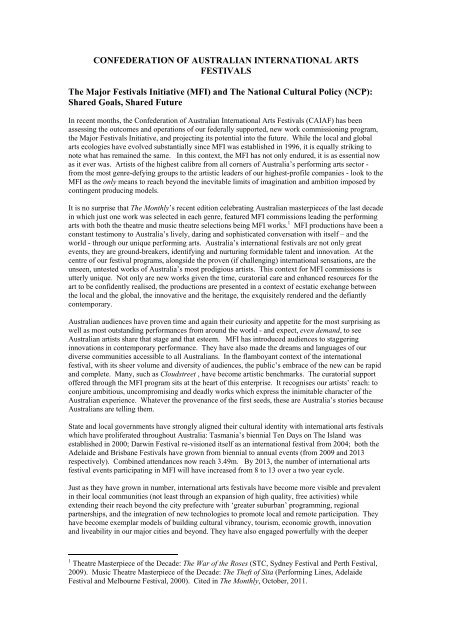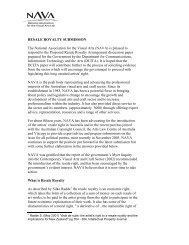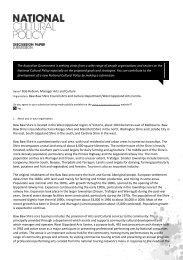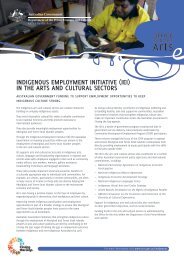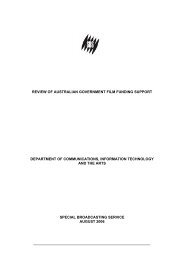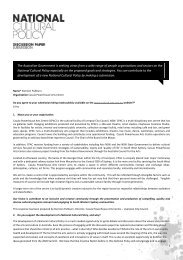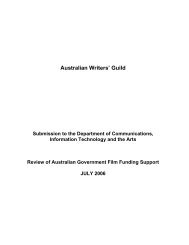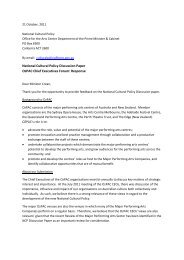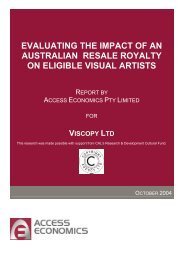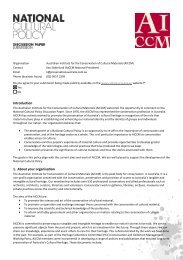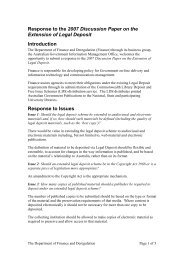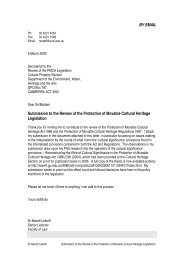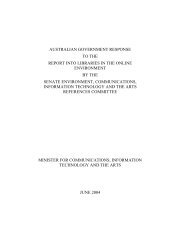Confederation of Australian International Arts ... - Creative Australia
Confederation of Australian International Arts ... - Creative Australia
Confederation of Australian International Arts ... - Creative Australia
Create successful ePaper yourself
Turn your PDF publications into a flip-book with our unique Google optimized e-Paper software.
CONFEDERATION OF AUSTRALIAN INTERNATIONAL ARTSFESTIVALS The Major Festivals Initiative (MFI) and The National Cultural Policy (NCP):Shared Goals, Shared FutureIn recent months, the <strong>Confederation</strong> <strong>of</strong> <strong><strong>Australia</strong>n</strong> <strong>International</strong> <strong>Arts</strong> Festivals (CAIAF) has beenassessing the outcomes and operations <strong>of</strong> our federally supported, new work commissioning program,the Major Festivals Initiative, and projecting its potential into the future. While the local and globalarts ecologies have evolved substantially since MFI was established in 1996, it is equally striking tonote what has remained the same. In this context, the MFI has not only endured, it is as essential nowas it ever was. Artists <strong>of</strong> the highest calibre from all corners <strong>of</strong> <strong>Australia</strong>’s performing arts sector -from the most genre-defying groups to the artistic leaders <strong>of</strong> our highest-pr<strong>of</strong>ile companies - look to theMFI as the only means to reach beyond the inevitable limits <strong>of</strong> imagination and ambition imposed bycontingent producing models.It is no surprise that The Monthly’s recent edition celebrating <strong><strong>Australia</strong>n</strong> masterpieces <strong>of</strong> the last decadein which just one work was selected in each genre, featured MFI commissions leading the performingarts with both the theatre and music theatre selections being MFI works. 1 MFI productions have been aconstant testimony to <strong>Australia</strong>’s lively, daring and sophisticated conversation with itself – and theworld - through our unique performing arts. <strong>Australia</strong>’s international festivals are not only greatevents, they are ground-breakers, identifying and nurturing formidable talent and innovation. At thecentre <strong>of</strong> our festival programs, alongside the proven (if challenging) international sensations, are theunseen, untested works <strong>of</strong> <strong>Australia</strong>’s most prodigious artists. This context for MFI commissions isutterly unique. Not only are new works given the time, curatorial care and enhanced resources for theart to be confidently realised, the productions are presented in a context <strong>of</strong> ecstatic exchange betweenthe local and the global, the innovative and the heritage, the exquisitely rendered and the defiantlycontemporary.<strong><strong>Australia</strong>n</strong> audiences have proven time and again their curiosity and appetite for the most surprising aswell as most outstanding performances from around the world - and expect, even demand, to see<strong><strong>Australia</strong>n</strong> artists share that stage and that esteem. MFI has introduced audiences to staggeringinnovations in contemporary performance. They have also made the dreams and languages <strong>of</strong> ourdiverse communities accessible to all <strong><strong>Australia</strong>n</strong>s. In the flamboyant context <strong>of</strong> the internationalfestival, with its sheer volume and diversity <strong>of</strong> audiences, the public’s embrace <strong>of</strong> the new can be rapidand complete. Many, such as Cloudstreet , have become artistic benchmarks. The curatorial support<strong>of</strong>fered through the MFI program sits at the heart <strong>of</strong> this enterprise. It recognises our artists’ reach: toconjure ambitious, uncompromising and deadly works which express the inimitable character <strong>of</strong> the<strong><strong>Australia</strong>n</strong> experience. Whatever the provenance <strong>of</strong> the first seeds, these are <strong>Australia</strong>’s stories because<strong><strong>Australia</strong>n</strong>s are telling them.State and local governments have strongly aligned their cultural identity with international arts festivalswhich have proliferated throughout <strong>Australia</strong>: Tasmania’s biennial Ten Days on The Island wasestablished in 2000; Darwin Festival re-visioned itself as an international festival from 2004; both theAdelaide and Brisbane Festivals have grown from biennial to annual events (from 2009 and 2013respectively). Combined attendances now reach 3.49m. By 2013, the number <strong>of</strong> international artsfestival events participating in MFI will have increased from 8 to 13 over a two year cycle.Just as they have grown in number, international arts festivals have become more visible and prevalentin their local communities (not least through an expansion <strong>of</strong> high quality, free activities) whileextending their reach beyond the city prefecture with ‘greater suburban’ programming, regionalpartnerships, and the integration <strong>of</strong> new technologies to promote local and remote participation. Theyhave become exemplar models <strong>of</strong> building cultural vibrancy, tourism, economic growth, innovationand liveability in our major cities and beyond. They have also engaged powerfully with the deeper1 Theatre Masterpiece <strong>of</strong> the Decade: The War <strong>of</strong> the Roses (STC, Sydney Festival and Perth Festival,2009). Music Theatre Masterpiece <strong>of</strong> the Decade: The Theft <strong>of</strong> Sita (Performing Lines, AdelaideFestival and Melbourne Festival, 2000). Cited in The Monthly, October, 2011.
cultural project <strong>of</strong> <strong>Australia</strong> in the 21 st century - that <strong>of</strong> realising national identity and communitycohesion through the arts.At its recent Annual General Meeting, CAIAF unreservedly endorsed the <strong><strong>Australia</strong>n</strong> Government’sNCP goals. It also re-committed itself to the MFI as an unparalleled, highly efficient, enduringlyflexible and proven national program that has no international peer. In response to its internal reviewas outlined below CAIAF will also implement a cluster <strong>of</strong> MFI modifications and new initiatives tobest reflect the opportunities and objectives <strong>of</strong> the program into the foreseeable future – and as aunique proposition for delivery <strong>of</strong> the <strong><strong>Australia</strong>n</strong> Government’s NCP’s goals.MFI: Why it Works and HowThe Major Festivals Initiative (MFI) is a unique performing arts commissioning and producingprogram initiated and managed by the <strong>Confederation</strong> <strong>of</strong> <strong><strong>Australia</strong>n</strong> <strong>International</strong> <strong>Arts</strong> Festivals(CAIAF) 2 which represents the major arts festivals <strong>of</strong> seven <strong>of</strong> the eight States and Territories (ACTdoes not have a significant multi-arts festival). It has no equivalent anywhere in the world and is theenvy <strong>of</strong> international festival directors worldwide as attested by the three recently appointedinternational directors <strong>of</strong> <strong><strong>Australia</strong>n</strong> festivals 3 .MFI commissions are new works initiated and principally created by <strong><strong>Australia</strong>n</strong> artists. Successfulprojects not only receive major commissioning funds to purchase creation time, experimentation and‘scale’, they benefit from the artistic guidance <strong>of</strong> the commissioning festivals and a high pr<strong>of</strong>ile,international presentation context in which they feature alongside the best from around the world.<strong>Australia</strong>’s international arts festivals provide unparalleled industry drawing power and leverage - MFIcommissions become the focus for national and international producers, presenters and visiting festivaldirectors. This leverage extends to national audience development as the festivals each attractunprecedented levels <strong>of</strong> local and visitor attendances and constitute a combined audience <strong>of</strong> 3.49m.Table 1<strong><strong>Australia</strong>n</strong> <strong>International</strong> <strong>Arts</strong> Festival Attendances (most recent figures)Festival Year Paid Attendance Unpaid Attendance Total AttendanceAdelaide Festival 2010 146 687 598 245 744 932Brisbane Festival 2011 47 444 961 065 1 008 509Darwin Festival 2011 30 496 57 482 87 978Melbourne Festival 2010 70 862 432 771 503 633Perth <strong>International</strong> <strong>Arts</strong> Festival 2011 196 332 148 470 344 802Sydney Festival 2011 132 972 (a) 514 381 (a) 647 353Ten Days On The Island 2011 28 626 125 000 153 626TOTAL 653 419 2 837 414 3 490 833(a) Conservative total as figures are unavailable for some major free eventsMFI only support works <strong>of</strong> uncommon scale, a criterion usually reflected in an unusually high number<strong>of</strong> performers and/or size <strong>of</strong> playing space, but it also recognises uncommon scale in a variety <strong>of</strong> otherways: complex cultural collaborations, hybrid art-forms, works which integrate new technologies, etc.Uncommon scale may also be determined by exceeding the scale <strong>of</strong> work the initiating artist usuallyworks at, eg. a project group stepping up to fill a larger and more formal space, or a state theatretackling a play cycle beyond its normal artistic remit. While <strong>Australia</strong>’s performing arts scene ishighly productive and vibrant, it is also exceptionally lean and efficient by international standards. MFIsupport allows our artists rare opportunities to dream and stretch their practice in ways otherwiseunimaginable.2 All CAIAF festivals are curated, multi-artform festivals with an international focus. CAIAF FullMembers: Melbourne <strong>International</strong> <strong>Arts</strong> Festival, Ten Days on the Island (Tasmania), AdelaideFestival <strong>of</strong> <strong>Arts</strong>, Perth <strong>International</strong> <strong>Arts</strong> Festival, Darwin Festival, Brisbane Festival, and SydneyFestival. CAIAF Associate Members (non voting) include: Auckland Festival, NZ <strong>International</strong> <strong>Arts</strong>Festival, Christchurch Festival.3Jonathan Holloway (UK): Perth <strong>International</strong> <strong>Arts</strong> Festival, Lieven Bertels (Netherlands): SydneyFestival; David Sefton (UK/US): Adelaide Festival
All new works <strong>of</strong> exceptional ambition require a heavy investment in time. MFI supports an initialseeding and development process. Artists may be supported incrementally up to and including thepoint <strong>of</strong> being definitively programmed, from the beginning to the end <strong>of</strong> their creative process: fromseeding an idea, to a workshop showing, to development and rehearsal. The commissioning festivalsare in regular contact with the artists, especially at critical moments in the work’s evolution. Thisunique relationship from conception to curtain-up ensures the greatest chance <strong>of</strong> success for new work,and the most supportive context for its presentation.MFI is a uniquely open and accessible program in the performing and interdisciplinary/multi-mediaarts. <strong><strong>Australia</strong>n</strong> performing arts groups and companies <strong>of</strong> every conceivable genre, provenance andscale are free to propose projects to CAIAF’s artistic directors.Guidelines up until the recent review were as follows: To attract MFI support, producers must secure a programming commitment from at least twoCAIAF festivals. Each festival must commit to invest 10% each <strong>of</strong> the total pre-production costs (ie. the cost<strong>of</strong> creating the work). Each festival also agrees to meet all presentation costs (including artists’ fees, venue andtechnical costs, marketing and publicity, a share <strong>of</strong> remount and transfer expenses to thesecond festival, etc.). The successful producer also contributes 10% towards pre-production while MFI contributesthe balance (usually the remaining 70%, less if there is a third or fourth presenter, eachcontributing a further 10% or other funding brought to the table). Box <strong>of</strong>fice is shared against an agreed formula between each Festival and the producerdependant on circumstances and commercial negotiations between the parties.The MFI forum is at once collegiate, rigorous and highly competitive. The most outstanding projectsare consensually identified through a vote <strong>of</strong> CAIAF members.MFI: New MovesThe following modifications have been implemented subsequent to internal review and CAIAF’sresponse to the NCP Discussion paper.Partnership and Investment StructureA maximum <strong>of</strong> 50% <strong>of</strong> production contribution will be available through MFIThe number <strong>of</strong> presenting partners to be increased from two to at least three includingtwo CAIAF festivals with a commitment between the partners <strong>of</strong> a minimum <strong>of</strong> 30% intotal (the split to be determined on a case by case basis, rather than a mandated 10% each)Associated New Zealand festivals may be one <strong>of</strong> the three presenting partners as canother venues or festivals within <strong>Australia</strong> or from abroadThese new parameters are designed to both drive further investment from member festivalsand producing partners as well as broadening the reach <strong>of</strong> the program through additional upfrontcommitments by non-CAIAF presenters.The Development SiteCAIAF has partnered with the <strong>Australia</strong> Council to re-vision the previously ad hocDevelopment Site which was funded through the now exhausted endowment <strong>of</strong> the<strong>Confederation</strong> Foundation (a legacy <strong>of</strong> funds remaining from a Bicentennial grant for a tourby the Chicago Symphony Orchestra). The Development Site has, over a decade, acted as anincubator and showcase for new projects that have potential for MFI funding.
Table 2MFI Development SiteLocationNumberPresentationsSeed Funding Event Cost Productions ApprovedFor MFI Funding2009 Sydney 24 $ 85 000 $ 42 000 4 <strong>Creative</strong> Developments3 Full Productions2006 Melb 21 $ 47 420 $ 30 000 8 Full Productions2004 Melb 5 Incl in Event Cost $ 46 000 1 Full Production2002 Brisb 11 $ 65 000 $ 15 000 4 Full Productions2001 Adel 21 Incl in Event Cost $140 000 4 Full Productions1998 Adel Not Recorded $ 55 000 n/a 5 Full ProductionsUnder a five year partnership agreement with the <strong>Australia</strong> Council, MFI will receive$100 000pa (<strong>Creative</strong> <strong>Australia</strong> funds) towards the curation and delivery <strong>of</strong> threeDevelopment Sites: May 2012, September 2013, and May 2015.The Development Site will involve seed funding <strong>of</strong> ideas, creative development andshowings <strong>of</strong> works-in-progress and other relevant initiatives from time to time.The MFI will curate the Site with the view to inviting additional presenters, producersand international presenters to view presentations and meet artists.The Site will still primarily serve the MFI commissioning needs - and securing additionalproducing partners for select projects - but will additionally assume a targeted advocacyand brokering role for curated projects and artists.The Development Site, with its additional secured funding, more predictable schedulingand targeted outcomes will generate a greater sense <strong>of</strong> creative milieu and enhance thedual dialogues <strong>of</strong> nurture and critical response.The shared expectation is that at least 15 works will be created as a result <strong>of</strong> the DevelopmentSite (these works may result in productions other than programming through MFI).New DirectionsThere are numerous new fronts which feature <strong><strong>Australia</strong>n</strong> artists as major innovators and trendsetters. MFI recognises that these are in no way bound to the use <strong>of</strong> new technologies.Notwithstanding some notable historical examples however, MFI expects more explicitexploration and use <strong>of</strong> technology as a performance platform may become a future focus.MFI expressly notes its enthusiasm for the NBN rollout and the potential for new partnerships,new audience relationships and newly conceived, media created projects as a result <strong>of</strong> thisbroad reaching and untested capacity.MFI are in active discussion with the SBS/Foxtel STVDIO channel with a view to developinga ‘first right <strong>of</strong> refusal arrangement’ to film and broadcast select MFI supported projects.Such an agreement would be dependent on pre-production contribution as well as all relevantoverheads thereby driving further investment in MFI projects. This model has already beentested with the successful recording and broadcast <strong>of</strong> Sydney Festival’s Smoke and Mirrors.Global RoamingMFI recognises that while it has an important advocacy role to play in extending the life <strong>of</strong>MFI commissions, it has no direct responsibility, nor the infrastructure to assume any. WhileMFI projects have an excellent track record <strong>of</strong> traveling abroad, success has not been achievedby strategy but rather through the sheer quality <strong>of</strong> the work or the good <strong>of</strong>fices <strong>of</strong> agencies likePerforming Lines.
The <strong><strong>Australia</strong>n</strong> context <strong>of</strong>fers significant hurdles already:‣ unlike our European counterparts, few MFI projects are produced by ensemble basedcompanies – costs <strong>of</strong> remounting for international seasons must be fully recovered‣ <strong><strong>Australia</strong>n</strong> touring is not structured around predictable circuits and seasons andcannot be scheduled with any certainty – sell-<strong>of</strong>fs to international presenters can’ttheoretically be on the back <strong>of</strong> even an ideal schedule to help amortise costs‣ Northern hemisphere festival and presenting venue seasons are <strong>of</strong>ten not aligned with<strong><strong>Australia</strong>n</strong> festival dates‣ the <strong><strong>Australia</strong>n</strong> dollar has inflated even the modest recovery costs <strong>of</strong> straight presenterfees‣ international fares and freight are largely prohibitiveA significant opportunity to expose projects (early in their development) to internationalpresenters can now be more strategically delivered under the new Development Site.This could result in:‣ an opportunity to invest in new works as a producing and presenting partner‣ advance commitment to present works directly out <strong>of</strong> their premiere season for apresenter fee (but without the need to charge remount costs)‣ a strong interest leading to attendance at premiere seasons and future programming‣ jointly conceived projectsMFI partner producers come from all sectors <strong>of</strong> the industry. There is no single strategy,approach, experience set or understanding <strong>of</strong> a common market. Key Organisations are eitherin receipt <strong>of</strong> <strong>International</strong> Multi-Year agreements or have to apply under ad hoc, highlycompetitive rounds with little certainty <strong>of</strong> success.A modest but self-managed fund exclusively to support MFI commissioned works could be ahighly effective tool.Refer below: Global Roaming: Pitch #2MFI: Staging SuccessSince the inaugural MFI production in 1997, MFI has enabled the commissioning and presentation <strong>of</strong>55 new <strong><strong>Australia</strong>n</strong> works ranging from bi-lingual Indigenous story telling to adaptations <strong>of</strong>Shakespeare’s history plays, from contemporary dance meeting robotics, to Indonesian shadowpuppetry accompanied by a fusion <strong>of</strong> jazz and gamelan, from dance inspired by the construction (andcollapse) <strong>of</strong> bridges to a Shanghai theatre noir fused with martial arts and acrobaticsMFI commissions have been presented in 132 <strong><strong>Australia</strong>n</strong> seasons and in excess <strong>of</strong> 50 internationalseasons, from regional NSW to Perth, from Darwin to New York City. (See Appendix)These productions represent an extraordinary celebration <strong>of</strong> <strong><strong>Australia</strong>n</strong> performing arts. They describean artistic culture <strong>of</strong> ‘world stage’ calibre and capacity; a deep respect and celebration <strong>of</strong> Indigenousculture in its contemporary and heritage expressions; and a self-conscious and inspired exploration <strong>of</strong>our diverse cultural heritage. The overwhelming success <strong>of</strong> these productions also speaks <strong>of</strong> a nationthat is highly supportive <strong>of</strong> its artists.
While CAIAF festivals are state-based and funded, MFI represents the federal government’s onlyongoing intervention in these high impact cultural events. Through federal funding, MFI hasrecognised our international arts festivals as uniquely placed to support the creation <strong>of</strong> tomorrow’srepertoire. MFI is the only enduring opportunity for our vastly talented organisations and individuals,from the majors to the independent and medium sectors, to pitch for that idea which only theinternational arts festivals in conjunction with MFI can make a reality.From 1996 to 1999, the MFI program received $0.5m annually from the <strong>Australia</strong> Council. Inrecognition <strong>of</strong> the success <strong>of</strong> the program, the growing cost <strong>of</strong> production (which could not berationalised in the live arts) and the increasing recognition <strong>of</strong> <strong><strong>Australia</strong>n</strong> performing arts excellence onthe national and international stage, this was increased to $0.75m annually with an additional $100,000per annum allocated in 2011 for Development Site. Neither funding level was indexed. The followingclearly illustrates the impact <strong>of</strong> MFI funding levels in achieving its goals.Table 3MFI Federal InvestmentPeriodFederalFundingPerAnnumMFISupportedPremieres(a)PremieresPerAnnum(b)ProducingPartnersPartnersPerProject(d)(c)1997 to 2000 $0.5m 15 Premieres 3.75 31 2.06 First season in 97Increase in 2000 notimpacted til 20012001 to 2006 $0.75m 22 Premieres 3.66 54 2.452007 to 2012 $0.75m 17 Premieres 2.83 41 2.41 2013 commitments notincludedNote(a)(b)(c)(d)MFI Supported Premieres: projects supported by MFI which proceeded to full production counted in the year <strong>of</strong> theirfirst performance.Premieres Per Annum: the number <strong>of</strong> MFI premieres in each year <strong>of</strong> the periodProducing Partners: the number <strong>of</strong> partnering Festivals and third parties who committed pre-production fundsPartners Per Project: the average number <strong>of</strong> partnering Festivals and third parties per production over the periodIn the second tranche <strong>of</strong> six years, following the annual increase from $0.5m to $0.75m, the averageannual number <strong>of</strong> productions annually remained at similar levels. In the third tranche <strong>of</strong> six years,from 2007 to 2012 (which has been allocated), the average number <strong>of</strong> annual productions hasdecreased by more than 20%.The potential for additional partner income (ie. at 10% contribution each) has not materialised,remaining at an average <strong>of</strong> 2.4 partners per production over the second and third tranches.The increase in costs per production (refer Table 5) – a well documented phenomenon in <strong><strong>Australia</strong>n</strong>performing arts over the past decade 4 – is testament both to greater than CPI increases in base lineproducing costs and an increasing sophistication in the nature <strong>of</strong> the productions, eg. the technologyand specialist skills required, a mobile artistic community who need to be transported andaccommodated, and the additional time and personnel involved in complex collaborations (breakingboundaries, taking risks, revealing the new, etc.) in content and form, as well as cultures and genres.In the last five years, four projects have required MFI production investment <strong>of</strong> over $400k each - iemore than half <strong>of</strong> the annual allocation.As featured events receiving concentrated attention and competing with the world’s best on ourinternational festival stages, it is not possible to rationalise the input without rationalising the outcome.Involving the General Managers and Artistic Directors <strong>of</strong> seven <strong>of</strong> the country’s most sophisticated,publicly funded cultural entities, the CAIAF assessment process is rigorous and highly specialised,financially as well as artistically. With ever-reducing real funds available, the only alternative is toreduce the number <strong>of</strong> productions, thereby reducing both opportunity and the likelihood <strong>of</strong> success inwhat is an inherently risky field.4 Refer AMPAG Major Theatre Reports, 2006 and 2009.
Table 4MFI Top Ten Financial InvestmentsYear <strong>of</strong>PremiereProduction& Key <strong>Creative</strong>s2007 NavigatorLiza LimBarrie KoskyMFIInvestment(a)$ 499,360 ContemporaryOperaGenre MFI Producers <strong>International</strong>SeasonsMelbourneBrisbaneBerlin2010 Ngurrumilmarrmiriyu(Wrong Skin)The Chooky DancersNigel Jamieson2010 Shanghai LadykillerStalkerRachael SwaineTony Ayres2006 Ngapartji NgapartjiBig hARTScott RankinTrevor Jamieson $ 433,423$ 422,835 IndigenousHybridNewTechnologiesMulti-lingual$ 400,000 Physical TheatreHybridNewTechnologiesMulti-lingualIndigenousMulti-lingualAdelaideDarwinSOHMalthousePerforming/LBrisbaneMelbourneMelbournePerthSOHSydneyPendingDocumentary filmNothing Rhymes withNgapartji2006 DevolutionADTGarry Stewart2005The Garden <strong>of</strong> ParadiseTerrapin TheatreGraeme MurphyBen Winspear$ 321,041 ContemporaryDanceNewTechnologiesPuppetry$ 307,727 DanceNewTechnologiesSydneyAdelaideTen Days on theIslandMelbourne2008 The Age I'm InForce MajeureKate Champion$ 261,762 Dance Theatre SydneyAdelaideDublinMontrealSeoul2009 The War <strong>of</strong> the RosesSTCBenedict AndrewsTom Wright2005 OdysseyMalthouse TheatreMichael KantorTom Wright2003 Tense DaveChunky MoveGideon ObarzanekMichael KantorLucy Guerin$ 256,103 ContemporaryTheatre$ 255,091 ContemporaryTheatre$ 182,777 ContemporaryDanceSydneyPerthMelbournePerthMelbourneSydneyAdditional Seasons:PerthAdelaideBrisbaneMelbourne (return)PortlandMassachusettsNew YorkAverageInvestment$334,011(a) and (b) Production Investment only: Odyssey, Ngapartji, Shanghai Lady Killer, The Age I'm In and Navigator also receiveddevelopment funds.
Finally, as outlined in the introductory remarks, since the introduction <strong>of</strong> MFI in 1996, the number <strong>of</strong>festivals eligible to compete for MFI new work commissioning support has increased by 62%, from 8to 13, over a two year event cycle. Without addressing this, we are at risk <strong>of</strong> <strong>Australia</strong>’s internationalarts festivals reducing their perceived commitment to new <strong><strong>Australia</strong>n</strong> work as there will not besufficiently resourced projects <strong>of</strong> the necessary calibre and ambition to program alongside the world’sbest.Table 5 Growth in the Number <strong>of</strong> <strong><strong>Australia</strong>n</strong> <strong>International</strong> Festival Events Per 2 Year Cycle since 1996<strong>International</strong> <strong>Arts</strong>FestivalStatus Relative to MIF 1996EventsPer 2 YearCycleBy 2000EventsPer 2 YearCycleBy 2006EventsPer 2 YearCycleBy 2013EventsPer 2 YearCycleAdelaideBiennial1 1 1 2Annual from 2013Sydney Annual 2 2 2 2Melbourne Annual 2 2 2 2Perth Annual 2 2 2 2BrisbaneDarwinTen Days on theIsland# MFI EligibleEvents Over2 Year CycleMFI FundingPer AnnumBiennialAnnual from 2009Annual<strong>International</strong> Status from 2004BiennialEstablished 20001 1 1 22 21 1 18 9 11 13$0.5m $0.75m $0.75m $0.75mMFI Ongoing Federal Support: Pitch #1To raise the federal government’s investment in the MFI program to $1.2m annually (indexed) from2012/13. Such support would enable the delivery <strong>of</strong> approximately four major premieres per annumand substantially increase the reach <strong>of</strong> that work both within <strong>Australia</strong> and internationally. It wouldalso enable the production <strong>of</strong> at least one MFI work within each <strong>of</strong> the 7 major festivals <strong>of</strong> CAIAFannually. Such a level <strong>of</strong> support would more or less reinstate the <strong><strong>Australia</strong>n</strong> Government’scommitment, in real terms, to its 2000 level but would generate more productions and morepresentations as a result <strong>of</strong> CAIAF’s re-visioned approach to partnership requirements andcollaborations with other <strong><strong>Australia</strong>n</strong> and international festivals, arts centres and other presenters.MFI Initiative Support for Global Roaming: Pitch #2Under its New Directions, Global Roaming initiative, MFI submit to the NCP framework to makeavailable the amount <strong>of</strong> $100,000 per annum exclusively for allocation through the MFI program forthe benefit <strong>of</strong> MFI commissioned projects to strategically support the export <strong>of</strong> new <strong><strong>Australia</strong>n</strong> workand the potential for collaboration and exchange between <strong><strong>Australia</strong>n</strong> and international artists.See Case Study #6 Valid Passports: Chunky Move’s Tense DaveMFI: The Generator is Running
It is difficult to give precise information about the financial impact <strong>of</strong> MFI, due to the breadth <strong>of</strong> theprogram and the many partners involved. However, a sample <strong>of</strong> 16 productions over a six year period,costing a total <strong>of</strong> $13 million, was produced and presented across <strong>Australia</strong> for a total investment bythe Federal Government <strong>of</strong> some $3 million (23%) – a relatively modest proportion compared toregular arts funding levels.<strong>Australia</strong>’s international arts festivals made a collective investment in these works <strong>of</strong> around $5.9million, with an additional $2 million being contributed from co-presenting arts companies and otherfederal and state funds. Royalties have been re-invested in the creation and presentation <strong>of</strong> even moreproductions.Case StudiesMFI brings the impossible within reach. Many smaller, specialist artform companies with big, boldideas have developed their national and international reputations beginning with MFI support. Andeven our most successful, major performing arts organisations cannot hope to produce grand scalework <strong>of</strong> dazzling sophistication inside their annual program capacity. Works commissioned throughMFI have become benchmark productions, spinning artists into stellar careers and providing equallystellar experiences for <strong><strong>Australia</strong>n</strong> and international audiences.Case Study #1Building a RepertoireKate Champion’s Force Majeure CompanyCase #2Even the Big Guns Need PowderSTC’s The War <strong>of</strong> the RosesCase Study #3The New WorldNigel Jamieson’s The Theft <strong>of</strong> SitaCase Study #5It’s Like It Was Always ThereCompany B and Black Swan’s CloudstreetCase Study #6The Long Way HomeElcho Island and The Chooky DancersNgurrumilmarrmiriyCase Study #7 Valid PassportsChunky Move’s Tense DaveCase Study #4You Give Me Something, I’ll Give YouSomethingBig hART’s Ngapartji NgapartjiCase Study #1 Building a RepertoireKate Champion’s Force Majeure CompanyKate Champion’s Force Majeure company wasestablished in 2002. Force Majeure createsaward winning hybrid works based in dancetheatre but also through collaborations withvisual artists, actors, writers and film makers.The results are challenging, poignant andstrikingly theatrical – they have an immediatebut lingering emotional impact. Creating aninterdisciplinary, choreographic based workfor the main stage usually requires a full timecompany for at least six months, twelve if youhope to tour. <strong>Australia</strong> has fewer than five fulltime contemporary dance companies <strong>of</strong> anyscale nationally… With almost no permanentinfrastructure Force Majeure has created tw<strong>of</strong>ull length, mainstage works <strong>of</strong> great powerand beauty through MFI commissions: theseminal Same Same But Different (Sydney,Brisbane and Melbourne Festivals) followedby The Age I’m In (Sydney and AdelaideFestivals). A third MFI commission, NeverDid Me Any Harm (Sydney Theatre Company,Sydney, Adelaide and Melbourne Festivals)opens in January. It is perfectly arguable thatForce Majeure’s repertoire has been madepossible through MFI support whiledemonstrably creating new audiences forcontemporary dance. As a result <strong>of</strong> thesefestival presentations, Kate’s work has alsobeen invited to perform in Dublin, Seoul,Montreal, and Lyon. Quality outcomes forquality work, and a career for the companythat probably wouldn’t have happenedotherwise.
Case Study #2 Even the Big Guns Need PowderSTC’s The War <strong>of</strong> the RosesIt might be imagined that the Sydney TheatreCompany, in cahoots with Sydney Festival,could manage a production <strong>of</strong> Shakespeare’sThe War <strong>of</strong> the Roses cycle featuring CateBlanchett from within existing resources. Thesheer scale <strong>of</strong> this project, however, meant thatexternal investment was critical to fund theunprecedented thirteen week rehearsal period,three week technical and dress rehearsalperiod, commissioning fees, guest artists andmultiple settings required to realise theambition <strong>of</strong> the production. Many in theaudience would have been seeing adeterminedly contemporary theatre production<strong>of</strong> this scale by <strong><strong>Australia</strong>n</strong> artists for the veryfirst time. It has become one <strong>of</strong> the absolutebenchmarks in the contemporary rendering <strong>of</strong>a classic for the visionary qualities (andcohesiveness) <strong>of</strong> the adaptation, the productionconcept, stage and lighting design,incorporation <strong>of</strong> live music, and astonishingperformances – Benedict Andrews’ directionforegrounding the power <strong>of</strong> Shakespeare’slanguage, excavating the visceral truths <strong>of</strong> itspoetry through physical demands on the actors.It won every major award <strong>of</strong> 2009. At thetime, Andrews was already directingfrequently for Berlin’s Schaubuhne alongsidelegendary artists Thomas Ostermeier andMarius von Mayenberg where he would haveaccess to scaled up resources for everyproduction. We must create opportunities forour best and brightest to return home, not leastso our best actors and creatives can continuetheir hugely influential artistic collaboration.<strong><strong>Australia</strong>n</strong> artists, like their Europeancounterparts, deserve opportunities to be thisgood. We deserve to hear and see Shakespearethis good and <strong>of</strong> our own making. Theproduction received many invitations to tourinternationally (including the EdinburghFestival, Salzburg Festival, SchaubuhneBerlin, Zurich Theatre Festival) none <strong>of</strong> whichcould be taken up due to the extraordinarydemands on Cate Blanchett’s time as Co-Artistic Director <strong>of</strong> STC.Case Study #3 The New WorldNigel Jamieson’s The Theft <strong>of</strong> SitaDirector and devisor, Nigel Jamieson,composer, Paul Grabowsky and puppeteerPeter Wilson collaborated with Balinesecomposer I Wayan Gde Yudane and masterpuppeteer, I Made Sidia, to use the traditionalform <strong>of</strong> Balinese shadow puppetry, wayankulit, to give carriage to an essentiallycontemporary political story – the destruction<strong>of</strong> beauty and a way <strong>of</strong> life in the Balineseenvironment. It takes artists <strong>of</strong> enormous skillto collaborate outside their cultural norms, andmany moments <strong>of</strong> connection and testing overa long period. The most simple stories are thehardest to tell and the incorporation <strong>of</strong> a livegamelan and jazz fusion orchestra made thisproduction so authentically and essentially acultural hybrid – which, nonetheless, couldonly have been imagined and produced by<strong><strong>Australia</strong>n</strong>s! A major cross-cultural storytelling experience with generosity <strong>of</strong> spirit,consummate skill, a ‘community’ on stage andtime to hatch. The Theft <strong>of</strong> Sita toured theworld with Performing Lines as the producer.The resources to produce this production, thesetting for its <strong><strong>Australia</strong>n</strong> premiere seasons, andthe care for its creation, could only come viaMFI.
Case Study #4 You Give Me Something, I’ll Give You Something Big hART’s Ngapartji Ngapartji Conceived by co-creator and performer TrevorJamieson and director Scott Rankin, BighART’s production <strong>of</strong> Ngapartji Ngapartjipremiered in 2006 for the Melbourne, Perthand Sydney Festivals, in conjunction with theSydney Opera House. It is based on originalresearch undertaken since 1999 on Arrerntecountry in Mparntwe (Alice Springs). Thestory ranges from Jamieson’s people's firstencounter with whites in the 1840s andincludes the religious missions, custom, stolenkids and family tales. It features varioustraditional and pop songs, all in Pitjantjatjara,including Burt Bacharach's This Guy's In LoveWith You (for the courtship <strong>of</strong> Jamieson'sparents) and, perhaps most importantly,Talking Heads' Once In A Lifetime (akaWantiriyalani). While the water might beflowing underground, is it the same as it everwas? Not quite, as our postwar governmenthanded over Spinifex Country for 12 years <strong>of</strong>British nuclear testing from 1953. NgapartjiNgapartji was a large scale work incorporatingan ensemble <strong>of</strong> actors, live visual artists andchoir and had many layers involving languagelearning, teaching and maintenance,community development, crime prevention,cross cultural collaboration and creating newliteracy training models as well as film, art,policy and theatre making. Thedocumentary behind the making <strong>of</strong> NgapartjiNgapartji has recently been releasedinternationally. A true gift from thePitjantjatjara via <strong>Australia</strong>’s internationalfestivals.Case Study #5 It’s Like It Was Always ThereCompany B and Black Swan’s CloudstreetThere’s something about a classic that makesyou think it was always there. That’s how tens<strong>of</strong> thousands <strong>of</strong> <strong><strong>Australia</strong>n</strong>s feel aboutCloudstreet, Nick Enright and Justin Monjo’smonumental stage adaptation <strong>of</strong> Tim Winton’ssprawling novel. Cloudstreet was firstproduced by Company B Belvoir and BlackSwan under commission from the 1998Sydney and Perth Festivals. This 102-scenethree-part five-hour masterpiece travelled toMelbourne, Brisbane and Adelaide beforebeing seen in London (twice), Dublin, Zurich,New York, and Washington. The fundraisingto get it to London (the first time) was almostas legend as the production. It’s not <strong>of</strong>ten – in<strong>Australia</strong> – that the power <strong>of</strong> the stage beginsto transcend, in the public imagination, acontemporary work <strong>of</strong> literature. No-one whosaw it could forget it. Jonathan Holloway,current AD <strong>of</strong> the Perth Festival points toseeing it in the UK as one reason he came towork here. There is something so absolutelyand fundamentally familiar – andquintessentially characteristic <strong>of</strong> both NeilArmfield and Belvoir about Cloudstreet it’salmost impossible to imagine that in fact theresources required to adapt, rehearse andproduce this great, populist work <strong>of</strong> art wereonly available through MFI – if they’d had theidea to create this before MFI, it may neverhave happened. The subsequent TV seriesshown on Foxtel earlier this year wouldprobably not have been produced if it had notbeen for the astonishing success <strong>of</strong> the stageproduction.Case Study #6The Long Way Home
Elcho Island and The Chooky Dancers NgurrumilmarrmiriyuNigel Jamieson first saw The Chooky Dancers,a mob <strong>of</strong> teenaged Indigenous kids from upNorth with their version <strong>of</strong> Zorba the Greek onYouTube. When he was asked to curate theoutdoor stages for the First Night <strong>of</strong> SydneyFestival he invited them to perform…Therebegan a relationship which would culminate,artistically and emotionally, in anextraordinary collaboration between Nigel andhis creative team and the Elders andcommunity <strong>of</strong> Elcho Island in Arnhem Land.This project was massive in ambition, inbudget, in logistics and in spirit. SydneyOpera House and Adelaide Festival joinedforces with Malthouse Theatre and PerformingLines and – perfectly – Darwin Festival. Theflexible and collegiate relationship at the MFItable ensured that contributions didn’t need tobe equal to agree it was a great thing for thecommunity in Darwin to see the show.Ngurrumilmarrmiriyu (Wrong Skin) became aRomeo and Juliet tale <strong>of</strong> forbidden love in acommunity where the complex laws <strong>of</strong> `skin'and clan define all relationships. Performed bythe wildly spirited Chooky Dancers - whoseinterpretations included everything fromBollywood to Taiwanese martial arts alongsidetraditional creation stories -Ngurrumilmarrmiriyu also revealed how newtechnologies, in the hands <strong>of</strong> media-savvyyouth connected the remote with the globaland made us all fall in love. This was one <strong>of</strong>the largest MFI investments made. But withoutit, this magical, cross-cultural, dance, theatre,flash mob, charismatic performance wouldhave stayed a dream. The care taken on bothsides <strong>of</strong> this conjoining <strong>of</strong> orbits was joyful,exacting and time-rich (read = expensive) asfew <strong>of</strong> the Chooky Dancers or their Eldersspoke English, or rather, none <strong>of</strong> us producersspeak Yolŋu Matha, and the touring companyhad never been away from their land for morethan days at a time. This meant working inbursts and returning home betweendevelopment, making, first season and secondseason – a necessarily expensive way <strong>of</strong>working for a unique production.Case Study #6 Valid PassportsChunky Move’s Tense DaveAs Artistic Director <strong>of</strong> Melbourne’s ChunkyMove, you might find Gideon Obarzanek’sthoughts about contemporary dance somewhatdisarming: “… for the greater part <strong>of</strong> my adultlife my relationship to dance has beenquestioning its legitimacy as an art form. One<strong>of</strong> my strongest motivations in making newwork is a search for pro<strong>of</strong> that danceperformance is indeed a compelling medium <strong>of</strong>expression.” Then again, it is precisely thismotivation which has made Chunky Move one<strong>of</strong> <strong>Australia</strong>’s most surprising, accessible andinternationally presented companies. Gideon’scollaborators include <strong>Australia</strong>’s best dancers,but they also include leading film-makers,sculptors, architects, music makers ands<strong>of</strong>tware programmers. For his MFIcommission, Tense Dave, his chiefcollaborators were designer Ge<strong>of</strong>f Cobham,choreographer Lucy Guerin and directorMichael Kantor. While undeniably a thrillinginterrogation <strong>of</strong> the body in movement, it alsoproved to be a witty, perception-altering andstunningly cinematic work. With MFIadvocacy, Tense Dave was invited toPortland’s prestigious White Bird. There, itwas seen by Jacob’s Pillow and AmericanDance Festival who booked it for seasons thefollowing year. An invitation to New Yorkproved elusive. Chunky Move made thedecision to invest a managed loss from itsreserves to self-present a NYC season on theback <strong>of</strong> the North American tour. Audiencesand critics went mad for it and Tense Davewon a Bessy Award for Best Innovation inDance (the dance equivalent <strong>of</strong> a Tony) – arare key for unlocking opportunity. Thisresulted in back-to-back fee-paying invitationsto the Brooklyn Academy <strong>of</strong> Music and aseries <strong>of</strong> US dates for existing productions.Most importantly, this US connection led tothe creation <strong>of</strong> Connected, a major new workcommissioned through the New EnglandFoundation for the <strong>Arts</strong> with funding from anarray <strong>of</strong> US philanthropic foundations which isnow on an eight venue tour <strong>of</strong> North America.The advocacy from MFI and the company’scalculated risk to invest in the NYC season hashelped generate multi-year internationaltouring support from the <strong>Australia</strong> Council,hundreds <strong>of</strong> thousands <strong>of</strong> dollars in fees, andan international commission. An MFI GlobalRoaming fund would help repeat this story andhelp companies underwrite risk, investstrategically in key markets and facilitatetravel by key presenters. Chunky Move waslucky to have reserves – many companies andproject groups who partner with MFI do not…
Table 6NCP Goals achieved through MFI OutcomesNCP Goal Re-visioned MFI Outcome and New MovesGoal #1To ensure that what the 20% <strong>of</strong> all MFI funded projects since 1997 have been Indigenous stories inGovernment supports – and productions created or co-created by Indigenous artists with Communityhow this support is provided – participation. These productions have been presented across 31 seasons inreflects the diversity <strong>of</strong> a every state and territory <strong>of</strong> <strong>Australia</strong> and in 9 seasons internationally. It is21stC <strong>Australia</strong>, and protects intended that MFI will continue to feature a significant proportion <strong>of</strong>and supports Indigenous Indigenous works in the future.cultureMFI projects are at the forefront <strong>of</strong> artform innovation, <strong>of</strong>ten involvingcollaborations between disciplines, cultures and communities.A number <strong>of</strong> recent MFI projects have been bilingual. This is something wecannot pre-determine but, as a reflection <strong>of</strong> the culture we live in, wouldcontinue to encourage. The international festival stage is by definitionpolyglot.Goal #2To encourage the use <strong>of</strong>emerging technologies andnew ideas that support thedevelopment <strong>of</strong> new artworksand the creative industries,and that enable more peopleto access and participate inarts and cultureGoal #3To support excellence andworld-class endeavour, andstrengthen the role that thearts play in telling <strong><strong>Australia</strong>n</strong>stories both here and overseas<strong>International</strong> <strong>Arts</strong> Festivals are at the leading edge in adapting and cooptingnew technologies and social media not just as a means <strong>of</strong> one-waycommunication but as a medium and platform for engagement andparticipation.MFI uniquely identifies and supports the best work by the best <strong><strong>Australia</strong>n</strong>artists – a process which will be enhanced through the re-visionedDevelopment Site.MFI’s strengthens the role <strong>of</strong> the arts through the creation <strong>of</strong> significant newwork that has the potential to break new ground and forge new creative andproducing/presenting connections.MFI productions have an excellent track record in international touring andthis will continue. The opportunity outlined to assist in highly strategic wayswould enhance this further.Goal #4To increase and strengthen thecapacity <strong>of</strong> the arts tocontribute to our society andeconomy<strong>International</strong> arts festivals are uniquely able to access and engage with broadaudiences, <strong>of</strong>ten introducing people to ideas, cultures and artforms that mightbe confronting or alienating in another context. Current aggregated audiences<strong>of</strong> 3.4m are set to grow with the further increase in annual events (Adelaide)from 2013.The revised MFI guidelines will grow the number <strong>of</strong> partnerships, diversifythe income base and extend the life <strong>of</strong> the work.The scale <strong>of</strong> MFI work creates economic impact <strong>of</strong> itself and the proportion <strong>of</strong>Government investment relative to total cost is low relative to relevantbenchmarks in the performing arts.
APPENDIX Major Festivals Initiative ProjectsProductionRAISED BYWOLVESMASTERKEYCompany/ArtistsHandspan/RegurgitatorMaryMoore/MasakoTogawaPresentingFestivalsMelbourneAdelaideAdelaidePerthYearTERRAFORMING KAOS <strong>Australia</strong> Perth 1999Post FestivalSeasons1997 (Adelaide season did notproceed)1998 Shanghai Festival1998BLOOD VESSELStalker TheatreCo.AdelaidePerth19981998European TourCLOUDSTREETPOSSESSEDCompanyB/BlackSwan/APA (TourManager)<strong><strong>Australia</strong>n</strong> DanceTheatreSydneyPerthAdelaideSydney1998199819981999Melbourne, London (2seasons), Dublin, Zurich,New York, Washington,Adelaide, Brisbane,Sydney (return season)Barossa Valley MusicFestivalELECTRONIC BIGTOPSkadadaPerthSydney19991999GHOST WIFEOCHRE & DUSTTHE THEFT OFSITANIGHT ANDDREAMSCRYING BABYJonathanMills/DorothyPorterMargueritePepperProductionsNigelJamieson/PaulGrabowsky/Performing Lines(Tour Manager)Music TheatreSydney/ GeraldEnglishMarrugeku/StalkerMelbourneAdelaideSydneyPerthAdelaideBrisbane (QPAC)AdelaideMelbourneAdelaideMelbourneSydneyPerthSydney1999200020012000200020002000200120002001200120012002London, ZurichUK TourHannover, New York,London, UK Tour, Belfast,Zurich, Aarhus, Berlin,Rotterdam, Sydney OperaHouseHolland, Belgium, IrelandNGALYODMYTHOLOGIASKINTHE AUNT’SSTORYPlasticiensVolants/Mullwarr Dance<strong>Australia</strong>Sydney DanceCompanyBangarra DanceTheatreMelbourneTheatreCompanyMelbourneSydneySydney (Olympic <strong>Arts</strong>Festival)BrisbaneSydney (Olympic <strong>Arts</strong>Festival)BrisbaneMelbourneBrisbane20002001200020002000200020012002Brighton (UK), FranceTourAdelaide, Melbourne,Brisbane
ALICEYUE LING JIE(Moon SpiritFeasting)SAME, SAME BUTDIFFERENTTHE FORTUNES OFRICHARDMAHONYTESTIMONYLOVE IN THE AGEOF THERAPYBEASTY GRRRLBALCONIESWALKABOUTWORKSHOPINCOGNITARIVERLANDTHE ANATOMYLESSON OF DRTULPSANDAKANTHRENODYYirra YaakinNoongarTheatreElision EnsembleForceMajeure/Performing Lines(Tour Manager)QueenslandTheatreCo/PlayboxPaulGrabowsky/NigelJamieson/<strong><strong>Australia</strong>n</strong> ArtOrchestraPaul Grabowsky/Oz OperaMargueritePepperProductionsErth Visual &Physical Inc.Chamber MadeOperaStalker TheatreCo.WindmillPerforming <strong>Arts</strong>Elision EnsembleJonathanMills/Lou WeisPerthMelbourneAdelaideMelbourneSydneyBrisbaneMelbourneBrisbaneMelbourneSydneyMelbourneMelbourneSydneyBrisbane (QPAC)PerthTen Days (TAS)MelbourneSydneyAdelaide2001200120002001200220022002200220022002200220022003200320032003200320032004Berlin, Zurich, JapanSydney Opera House,Lyon Dance FestivalSydney Opera HouseAdelaide Cabaret Festival(Adelaide season did notproceed)Melbourne 2003 Development OnlySydneyPerthAdelaidePerthAdelaideBrisbaneBrisbaneMelbourneSydneyBrisbaneMelbournePerthTENSE DAVE Chunky Move MelbourneSydneyPerthEAVESDROPTHE GARDEN OFPARADISETHE ODYSSEYNot yet itsdifficult/Martin ThieleBenjaminWinspear/MichaelaFrench/TerrapinPuppet Co.The Black SwanTheatreCompany/MalthouseTheatrePerthBrisbaneSydneyTen Days on the IslandMelbournePerth FestivalMelbourne Festival200320032004200420042004200420042005200420042005200320042004200420042005The Netherlands, Italy,France, BelgiumJapanSingaporePortland, Massachusetts,New York City, Adelaide,BrisbaneParis2005 (Melbourne season didnot proceed)20052005
THREE FURIESStephenSewell/JimSharman/Performing LinesSydney FestivalPerth FestivalAdelaide FestivalDEVOLUTION ADT Adelaide FestivalSydney FestivalSTRUCTURE &SADNESSNGAPARTJINGAPARTJISNUGGLEPOT ANDCUDDLEPIELucy Guerin Inc.Big hArtCompany B/WindmillPerforming <strong>Arts</strong>Melbourne FestivalSydney FestivalMelbourne FestivalPerth FestivalSydney FestivalPerth FestivalSydney FestivalTHE AGE I’M IN Force Majeure Sydney FestivalAdelaide FestivalTHE NAVIGATOR Liza Lim Brisbane FestivalMelbourne FestivalTHIS SHOW ISABOUT PEOPLEShaun ParkerProjectsMelbourne FestivalSydney Festival200520062006200620072006200720062007200720072007200820082008200720072008Auckland FestivalSydney Opera HouseAdelaide Festival CentreDublin, Seoul, MontrealBerlinTHE NARGUN ANDTHE STARSTHE WAR OF THEROSESWHEN THEPICTURES CAMEUS (awakeningwhat is to come)EN MASSERINGING THECHANGESErth Visual andPhysicalSydney TheatreCompanySydney FestivalPerth FestivalSydney FestivalPerth Festival2009200920092009Terrapin Development Funds 2009 Children’s Art Theatre <strong>of</strong>China – ShanghaiCome Out AdelaideTen Days on the IslandGenevieveLacey/MarcSilverStrange Fruit/Graeme LeakAdelaide FestivalSydney Festival<strong>Arts</strong>house Melbourne forMelbourne FestivalMelbourne FestivalTen Days on the Island2010201120092011(Sydney season did notproceed)WomadelaideHAPPY AS LARRYShaun ParkerProjectsSydney FestivalPerth FestivalBrisbane Festival201020102010Wellington (NZIAF)NGURRUMILMARRMIRIYU(WRONG SKIN)SHANGHAI LADYKILLERBOUNDARYSTREETMY BICYLE LOVESYOUChookyDancers/ NigelJamieson/PerfLinesStalkerBlack SwanState TheatreCompanyLegs on the WallAdelaide FestivalMalthouse MelbourneDarwin FestivalBrisbane FestivalMelbourne FestivalPerth FestivalBrisbane FestivalSydney FestivalPerth FestivalWULAMANAYUWI Darwin FestivalTen Days on the Island201020102010Sydney Opera House2010 (Melbourne season didnot proceed)201120122011201120102010Come Out Festival(Adelaide)
ASSEMBLY Chunky Move Melbourne FestivalSydney FestivalBrisbane Festival201120122012NEVER DID MEANY HARMForce Majeure/Sydney TheatreCompanySydney FestivalAdelaide FestivalMelbourne Festival201220122012HOUSE OFDREAMINGArena TheatreCompanyMelbourne FestivalPerth FestivalBrisbane Festival201220132013Auckland Festival 2013SECRET RIVERSydney TheatreCompany/Bangarra DanceSydney FestivalPerth Festival20132013Centenary <strong>of</strong> CanberraFestival 2013


